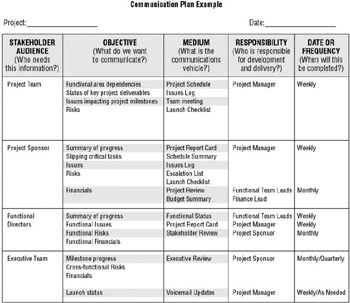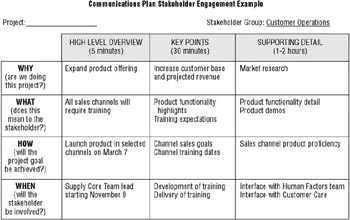Communications Planning
Good communication is one of the keys to project success. If you ask project managers to tell you how they spend their time, most will state that they spend anywhere from 50 to 80 percent of their time on project communication. You may have noticed in this book, we continually end a planning section with the need to communicate this information to team members or other stakeholders. A need for good communication starts from the day the project charter is issued and you are formally named project manager (perhaps even earlier if you have been filling the project manager role informally). The project charter is the first of many project documents that needs to be reviewed with your stakeholders. Unfortunately, even though project managers usually recognize how much time they spend communicating, this does not always translate into taking the time to develop a good communications plan.
| |
Once, one of us was a team lead on a project where the project manager created distribution lists for both email and paper documents and sent everything she received that even remotely involved the project to everyone on the lists. She thought she was doing an excellent job of communicating with the team, but the team was going crazy. We were buried with data, and much of it was not relevant to our role on the project. It got to the point where most of the team members were so overwhelmed we stopped reading everything. That, of course, led us to missing information we did need. The project manager did not understand why there was so much confusion on the team. She had not put any planning into her communications process.
| |
Good communication involves far more than just setting up distribution lists. You need a plan to determine what gets communicated to whom. Communications planning is the process of identifying what people or groups need to receive information regarding your project, what information each group needs, and how the information will be distributed. The communication system should monitor the project status and satisfy the diverse communication needs of the project's stakeholders.
We are going to review general principles of project communications strategy and then focus on some specific areas of concern for communicating with project team members and communicating with other stakeholder groups.
Communications Strategy
Communication is a part of our daily lives, both business and personal. Because people communicate all the time, they give little thought to organizing or planning communication.
Regardless whether you are communicating with your sponsor, team members, or your client, some simple steps will make your communication more effective.
-
Decide WHAT you wish to communicate.
-
Decide TO WHOM you wish to communicate.
-
Think about the BIASES of the receivers/listeners.
-
Decide HOW you should communicate.
-
COMPOSE and TRANSMIT the message.
It is not necessary to document these steps every time you communicate, but taking even 5 minutes to think through them will have the outcome of improving the focus and clarity of project communications. The importance of planning your communications before you speak or write is even more critical if your message is sensitive or controversial . Life is much easier if you send the right message to begin with, rather than apologizing or retracting at a later time.
Documenting an overall communications plan can be accomplished by: Defining who needs information on your project.
Listing communication objectives for this person or group.
Identifying the communications vehicle(s).
Assigning accountability to deliver the communication.
Determining when the communications will happen.
Figure 6.4 shows an example of a communications plan using this approach. Although the template from this example can be used to create an overall communications plan for all stakeholder groups, there are some additional considerations when it comes to communicating with your project team.

FIGURE 6.4 Communications Plan Example
Communicating with Project Team Members
One of your most important jobs as project manager will be communicating with your project team members. It is your responsibility to make sure all the team members understand the project goals and objectives and how their contribution fits into the big picture. Unfortunately, this is an area that is frequently overlooked in communications planning.
Your interactions with your project team will involve both formal and informal communications. Formal communications include project kickoff meetings, team status meetings, written status reports , team building sessions, or other planned sessions that you hold with the team. Informal communications include phone calls and emails to and from your team members, conversations in the hallway, and impromptu meetings.
The challenge that project managers face is to match their communication style with that of each team member. Getting input from your team members will help you better communicate with them. If you are scheduling a kickoff meeting or other team building session, ask for suggestions on agenda items or areas for team discussion. Team members may have suggestions for the structure and frequency of the team meetings or format for status reporting, based on their previous project experience. The project manager may not be able to accommodate all suggestions, but taking the time to consider input and reviewing the final format will go a long way toward building a cohesive team.
Everyone has a communications method they are most comfortable with; some of your team members may prefer to primarily use email, while other rely on phone calls or voicemail. For these informal one-on-one communications, where possible, work to accommodate what is most comfortable for each team member.
You may note that some of the other stakeholders may not understand how they are involved with the project. Extra steps are required to properly engage these people.
Engaging Stakeholders
Before you can develop a communications plan for the other stakeholders on your project, you need to identify who they are. In Chapter 2 we identified some of the typical project stakeholders: project sponsor, functional managers, customers, and end users. Remember that a stakeholder is anyone who will be positively or negatively affected by the outcome of a project.
On large projects that cross multiple functional areas, you may identify stakeholders who are not participating in the project or do not fully understand their role. This commonly occurs with large systems applications or new products that are deployed across geographic regions such as multistate customer operations areas or multicampus sites. If the customer operations director does not understand how his team is involved or what will be the total impact on his group, you need to get him connected to what's going on. But he may be busy and not paying attention to your project. So, if you can only get 5 minutes of time with an uninvolved stakeholder, it's vital that you spend your time wisely.
To accomplish your mission, it can be useful to develop an engagement plan that describes the key points you need to get across:
-
Identify which aspects of the project plan to communicate.
-
List any known or probable benefits or concerns from the stakeholder.
-
Determine key message(s) to convey to each stakeholder.
An example of a stakeholder engagement plan using the customer operations scenario for a new product deployment is shown in Figure 6.5.

FIGURE 6.5 Stakeholder Engagement Plan
This particular example uses three scenarios based on the amount of time you are spending with the stakeholder. This approach has two key benefits:
-
You have carefully thought out what you need to say if your time is limited.
-
You are ready for the next meeting or to extend your current meeting if the stakeholder wants more detail immediately.
Your communications plan is a document you need to review with your sponsor. If your project requires communication to executive team members, the sponsor can help develop the communications plan by identifying what information the group needs, and how and when communication will take place. In addition to the communications distribution structure, your communications plan may include information on how you will gather and store information, how to obtain information between communications, and how to update the communications plan.
EAN: 2147483647
Pages: 156